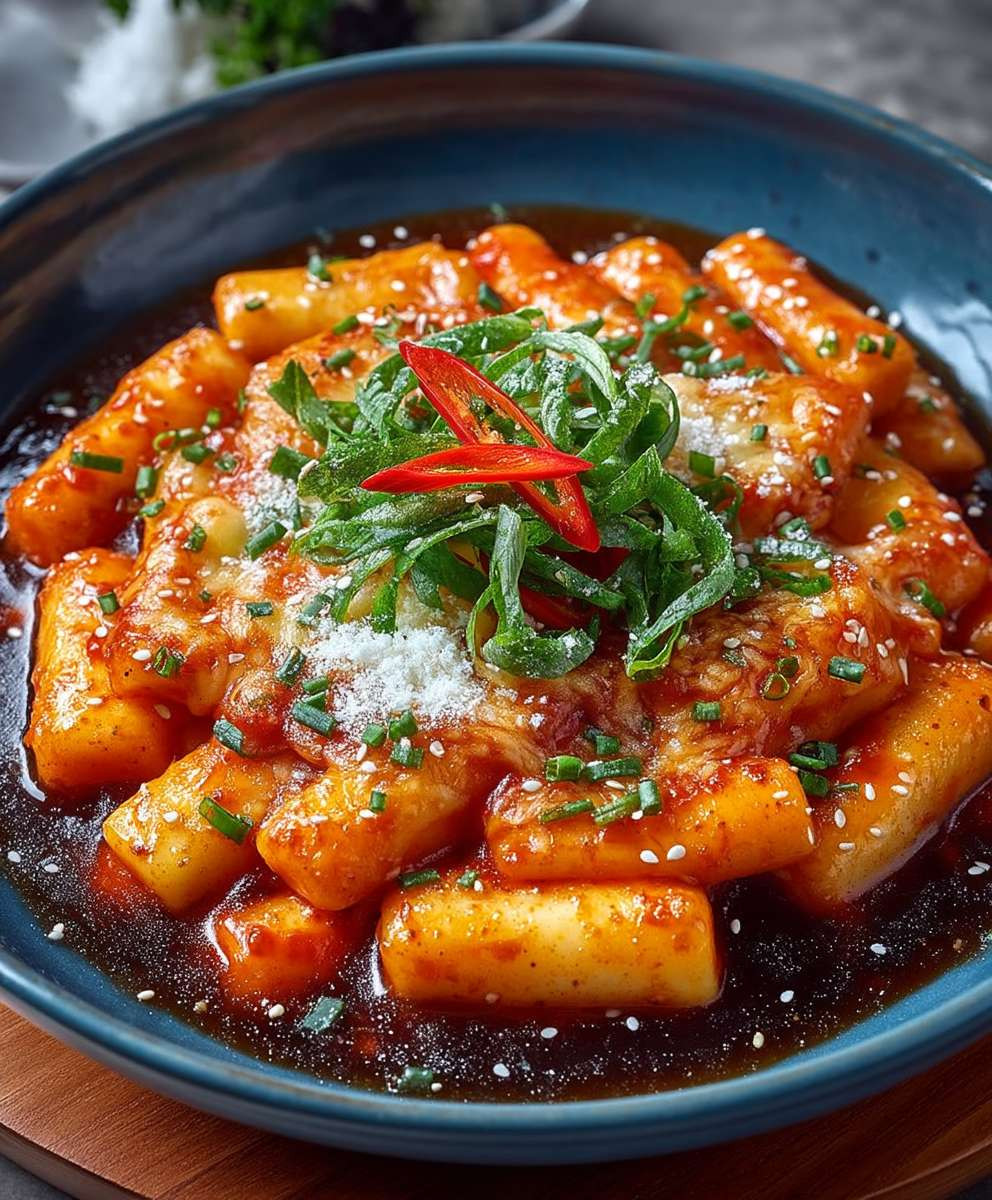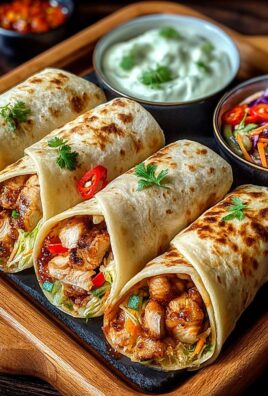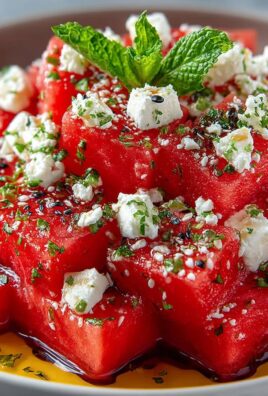Cheese Tteokbokki Korean Street Food: Get ready to experience a flavor explosion that will transport you straight to the bustling streets of Seoul! Imagine chewy rice cakes bathed in a fiery, savory sauce, now elevated with a blanket of gooey, melted cheese. This isn’t just any snack; it’s a culinary adventure that’s both comforting and exciting.
Tteokbokki, the heart of this dish, has a rich history in Korean cuisine. Originally a royal court dish called “gungjung tteokbokki,” it was a stir-fried rice cake dish made with various meats and vegetables. Over time, it evolved into the spicy, vibrant street food we know and love today. The addition of cheese is a more recent, modern twist, reflecting Korea’s embrace of global flavors.
What makes Cheese Tteokbokki Korean Street Food so irresistible? It’s the perfect balance of textures and tastes. The chewy, slightly sweet rice cakes contrast beautifully with the spicy, umami-rich gochujang sauce. And then, there’s the cheese! It adds a creamy, decadent element that mellows the spice and creates a truly addictive experience. Whether you’re a seasoned Korean food enthusiast or a curious beginner, this recipe is guaranteed to become a new favorite. So, grab your ingredients, and let’s bring the taste of Korea to your kitchen!
Ingredients:
- For the Tteok (Rice Cakes):
- 2 cups Korean rice cakes (tteokbokki tteok), cylindrical or oval shape
- 1 tablespoon sesame oil
- 1/2 teaspoon salt
- For the Sauce:
- 4 cups water
- 6 dried anchovies, gutted and cleaned (or 1 teaspoon anchovy powder)
- 1 piece (4×4 inch) dried kelp (kombu)
- 2 tablespoons gochujang (Korean chili paste)
- 1 tablespoon gochugaru (Korean chili powder)
- 1 tablespoon soy sauce
- 1 tablespoon sugar
- 1 teaspoon minced garlic
- 1/2 teaspoon black pepper
- For the Cheese Topping:
- 1 cup shredded mozzarella cheese
- 1/2 cup shredded cheddar cheese (optional, for extra flavor)
- Additional Ingredients (Optional):
- 1/2 cup fish cakes, sliced
- 1/4 cup scallions, chopped
- 1 hard-boiled egg, sliced (for garnish)
- 1/4 cup ramen noodles (pre-cooked)
- 1 tablespoon sesame seeds (for garnish)
Preparing the Anchovy Broth
The foundation of a great tteokbokki is a flavorful broth. We’re going to make a simple yet delicious anchovy broth that will infuse our rice cakes with umami.
- Prepare the Anchovies and Kelp: In a medium saucepan, combine the water, dried anchovies, and dried kelp. Make sure the anchovies are gutted and cleaned to avoid any bitterness. You can skip this step if you are using anchovy powder.
- Simmer the Broth: Bring the mixture to a boil over medium-high heat. Once boiling, reduce the heat to low and simmer for about 15-20 minutes. This allows the flavors of the anchovies and kelp to fully develop.
- Strain the Broth: After simmering, remove the saucepan from the heat. Using a fine-mesh sieve or strainer, carefully strain the broth into a clean bowl or pot. Discard the anchovies and kelp. We only want the flavorful liquid.
Making the Tteokbokki Sauce
Now comes the fun part – creating the spicy and savory sauce that defines tteokbokki! This sauce is a perfect balance of sweet, spicy, and umami.
- Combine Sauce Ingredients: In the pot with the strained anchovy broth, add the gochujang, gochugaru, soy sauce, sugar, minced garlic, and black pepper.
- Whisk Thoroughly: Whisk all the ingredients together until they are well combined and the gochujang is fully dissolved. This ensures a smooth and even sauce.
- Adjust to Taste: Taste the sauce and adjust the seasonings as needed. If you prefer a sweeter sauce, add a little more sugar. For a spicier kick, add more gochugaru. Remember, you can always add more, but you can’t take it away!
Cooking the Tteokbokki
With the broth and sauce ready, it’s time to cook the rice cakes and bring everything together. This is where the magic happens!
- Prepare the Rice Cakes: If your rice cakes are very firm, you can soak them in cold water for about 10-15 minutes to soften them slightly. This will help them cook more evenly. Drain the rice cakes before adding them to the sauce.
- Add Rice Cakes to the Sauce: Add the rice cakes to the pot with the sauce. Bring the mixture to a simmer over medium heat.
- Cook the Rice Cakes: Cook the rice cakes for about 8-10 minutes, or until they are soft and chewy and the sauce has thickened slightly. Stir occasionally to prevent the rice cakes from sticking to the bottom of the pot.
- Add Fish Cakes (Optional): If you’re using fish cakes, add them to the pot during the last 3-4 minutes of cooking. This will allow them to absorb the flavors of the sauce without becoming overcooked.
- Add Ramen Noodles (Optional): If you’re using ramen noodles, add them to the pot during the last 2-3 minutes of cooking. Make sure the noodles are pre-cooked according to package instructions.
Adding the Cheese and Finishing Touches
Now for the best part – the cheese! This is what transforms regular tteokbokki into cheesy, gooey goodness. We’ll also add some finishing touches to make it even more appealing.
- Add the Cheese: Reduce the heat to low. Sprinkle the shredded mozzarella cheese and cheddar cheese (if using) evenly over the tteokbokki.
- Melt the Cheese: Cover the pot with a lid and let the cheese melt for about 2-3 minutes, or until it is melted and bubbly. You can also use a kitchen torch to melt the cheese for a more browned and bubbly top.
- Garnish and Serve: Remove the pot from the heat. Garnish with chopped scallions and sesame seeds. You can also add sliced hard-boiled eggs for a classic touch.
- Serve Immediately: Serve the cheese tteokbokki immediately while it’s hot and the cheese is melted and gooey. Enjoy!
Tips for the Best Cheese Tteokbokki
- Use High-Quality Gochujang: The flavor of your gochujang will greatly impact the overall taste of your tteokbokki. Opt for a high-quality brand for the best results.
- Adjust the Spice Level: If you’re sensitive to spice, start with a smaller amount of gochugaru and add more to taste. You can also use a milder gochujang.
- Don’t Overcook the Rice Cakes: Overcooked rice cakes can become mushy. Cook them until they are soft and chewy, but still hold their shape.
- Experiment with Toppings: Feel free to add other toppings to your tteokbokki, such as vegetables (cabbage, onions, carrots), dumplings (mandu), or even sausages.
- Make it Vegetarian: To make vegetarian tteokbokki, omit the anchovies and kelp from the broth and use vegetable broth instead. You can also add tofu or mushrooms for extra protein.
- Storage: Leftover tteokbokki can be stored in an airtight container in the refrigerator for up to 2 days. Reheat it gently on the stovetop or in the microwave. You may need to add a little water to prevent it from drying out.
Variations on Cheese Tteokbokki
- Rose Tteokbokki: Add heavy cream or milk to the sauce for a creamy and less spicy version.
- Jajang Tteokbokki: Use jajangmyeon sauce (black bean sauce) instead of gochujang for a savory and slightly sweet flavor.
- Curry Tteokbokki: Add curry powder to the sauce for a unique and flavorful twist.
- Seafood Tteokbokki: Add shrimp, squid, or other seafood to the tteokbokki for a delicious and protein-rich meal.
Troubleshooting Common Tteokbokki Issues
- Sauce is Too Thick: If your sauce becomes too thick, add a little water or broth to thin it out.
- Sauce is Too Thin: If your sauce is too thin, simmer it for a few more minutes to allow it to reduce and thicken. You can also add a cornstarch slurry (1 tablespoon cornstarch mixed with 2 tablespoons water) to thicken it quickly.
- Rice Cakes are Sticking: To prevent the rice cakes from sticking to the bottom of the pot, stir them frequently and make sure there is enough liquid in the pot.
- Tteokbokki is Too Spicy: If your tteokbokki is too spicy, add a little sugar or honey to balance the flavors. You can also add a dollop of sour cream or yogurt to cool it down.
Health Benefits of Tteokbokki Ingredients
- Gochujang: Contains capsaicin, which has anti-inflammatory and antioxidant properties.
- Gochugaru: Rich in

Conclusion:
This isn’t just another recipe; it’s an invitation to experience the vibrant flavors of Korean street food right in your own kitchen. The combination of chewy tteok, spicy gochujang sauce, and the gooey, melty goodness of cheese creates a symphony of textures and tastes that’s simply irresistible. Trust me, once you try this Cheese Tteokbokki, you’ll be hooked! It’s the perfect comfort food for a chilly evening, a fun and interactive dish to share with friends, or even a satisfying solo indulgence.
But what truly makes this recipe a must-try is its versatility. Feel free to experiment with different types of cheese. Mozzarella is a classic choice for its incredible stretch, but provolone, cheddar, or even a sprinkle of parmesan can add unique flavor dimensions. For a spicier kick, add an extra spoonful of gochujang or a pinch of gochugaru (Korean chili flakes). If you prefer a milder flavor, reduce the amount of gochujang and add a touch of sugar to balance the spice.
Serving Suggestions and Variations:
* Classic Presentation: Serve your Cheese Tteokbokki hot, garnished with chopped green onions and a sprinkle of sesame seeds.
* Add Protein: Enhance the dish with sliced fish cakes (eomuk), boiled eggs, or even some crispy bacon for added protein and flavor.
* Vegetarian Delight: Load up on vegetables like cabbage, carrots, onions, and mushrooms for a more nutritious and satisfying meal.
* Ramen Noodles: For an extra hearty meal, add ramen noodles to the tteokbokki during the last few minutes of cooking. This variation is known as Rabokki and is incredibly popular!
* Side Dishes: Pair your Cheese Tteokbokki with some Korean side dishes like kimchi, pickled radish, or seasoned spinach for a complete and authentic Korean dining experience.
* Spice Level: Adjust the amount of gochujang to your preference. Start with a smaller amount and add more to taste. Remember, you can always add more spice, but it’s harder to take it away!
* Cheese Pull: For the ultimate cheese pull, use a combination of mozzarella and a cheese that melts well, like Monterey Jack.I’ve poured my heart into perfecting this recipe, and I’m confident that you’ll love it as much as I do. It’s a relatively simple dish to make, even for beginner cooks, and the results are incredibly rewarding. The combination of sweet, spicy, and cheesy flavors is truly addictive, and the chewy texture of the tteok is simply delightful.
So, what are you waiting for? Gather your ingredients, put on some upbeat K-pop music, and get ready to embark on a culinary adventure. I promise you won’t regret it! And most importantly, don’t be afraid to get creative and customize the recipe to your own liking. That’s the beauty of cooking – it’s all about experimenting and discovering new flavors.
I’m so excited for you to try this recipe and experience the magic of Cheese Tteokbokki for yourself. Once you’ve made it, please come back and share your experience in the comments below! I’d love to hear about your variations, your favorite toppings, and any tips or tricks you discovered along the way. Let’s create a community of Cheese Tteokbokki enthusiasts! Happy cooking!
Cheese Tteokbokki Korean Street Food: A Deliciously Cheesy Guide
Spicy, chewy Korean rice cakes (tteokbokki) smothered in a gochujang-based sauce and topped with melted mozzarella and cheddar cheese. A comforting and flavorful dish perfect for a quick meal or snack.
Ingredients
- 2 cups Korean rice cakes (tteokbokki tteok), cylindrical or oval shape
- 1 tablespoon sesame oil
- 1/2 teaspoon salt
- 4 cups water
- 6 dried anchovies, gutted and cleaned (or 1 teaspoon anchovy powder)
- 1 piece (4×4 inch) dried kelp (kombu)
- 2 tablespoons gochujang (Korean chili paste)
- 1 tablespoon gochugaru (Korean chili powder)
- 1 tablespoon soy sauce
- 1 tablespoon sugar
- 1 teaspoon minced garlic
- 1/2 teaspoon black pepper
- 1 cup shredded mozzarella cheese
- 1/2 cup shredded cheddar cheese (optional, for extra flavor)
- 1/2 cup fish cakes, sliced
- 1/4 cup scallions, chopped
- 1 hard-boiled egg, sliced (for garnish)
- 1/4 cup ramen noodles (pre-cooked)
- 1 tablespoon sesame seeds (for garnish)
Instructions
- Prepare the Anchovy Broth: In a medium saucepan, combine the water, dried anchovies, and dried kelp. Bring to a boil over medium-high heat, then reduce heat to low and simmer for 15-20 minutes. Strain the broth into a clean bowl or pot, discarding the anchovies and kelp.
- Make the Tteokbokki Sauce: In the pot with the strained anchovy broth, add the gochujang, gochugaru, soy sauce, sugar, minced garlic, and black pepper. Whisk until well combined. Adjust seasonings to taste.
- Cook the Tteokbokki: If rice cakes are firm, soak in cold water for 10-15 minutes. Drain and add to the pot with the sauce. Bring to a simmer over medium heat.
- Cook the rice cakes for about 8-10 minutes, or until they are soft and chewy and the sauce has thickened slightly. Stir occasionally to prevent the rice cakes from sticking to the bottom of the pot.
- Add Fish Cakes (Optional): If using fish cakes, add them to the pot during the last 3-4 minutes of cooking.
- Add Ramen Noodles (Optional): If using ramen noodles, add them to the pot during the last 2-3 minutes of cooking. Make sure the noodles are pre-cooked according to package instructions.
- Add the Cheese: Reduce heat to low. Sprinkle mozzarella and cheddar cheese (if using) evenly over the tteokbokki.
- Melt the Cheese: Cover the pot with a lid and let the cheese melt for about 2-3 minutes, or until melted and bubbly. You can also use a kitchen torch to melt the cheese for a more browned and bubbly top.
- Garnish and Serve: Remove from heat. Garnish with chopped scallions and sesame seeds. Add sliced hard-boiled eggs if desired. Serve immediately.
Notes
- Use high-quality gochujang for the best flavor.
- Adjust the spice level by adding more or less gochugaru.
- Don’t overcook the rice cakes.
- Experiment with toppings like vegetables, dumplings, or sausages.
- For vegetarian tteokbokki, omit the anchovies and kelp and use vegetable broth.
- Leftovers can be stored in the refrigerator for up to 2 days. Reheat gently on the stovetop or in the microwave.
- If the sauce is too thick, add water or broth. If it’s too thin, simmer longer or add a cornstarch slurry.
- To prevent rice cakes from sticking, stir frequently and ensure enough liquid.
- If too spicy, add sugar or honey, or a dollop of sour cream or yogurt.




